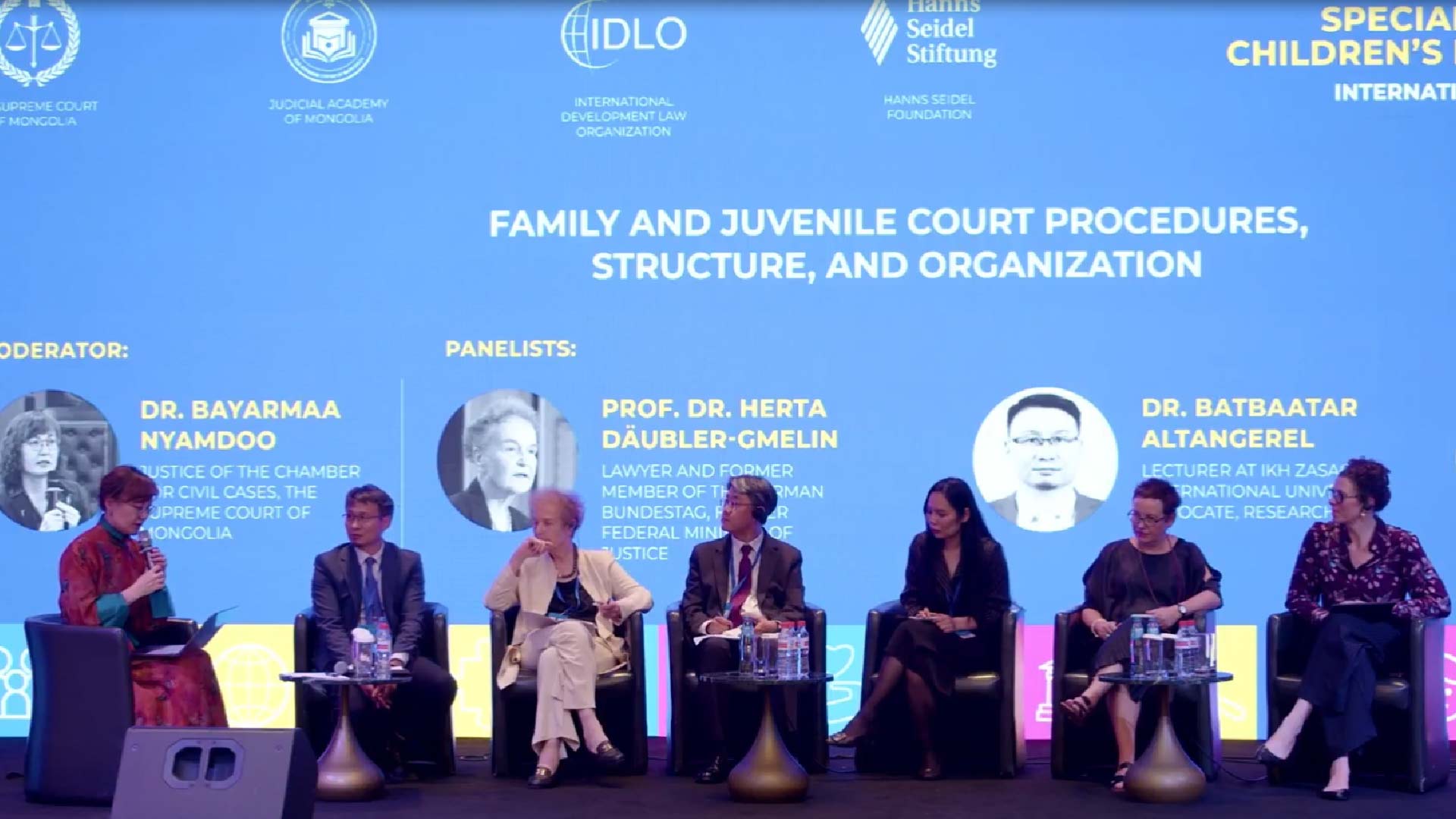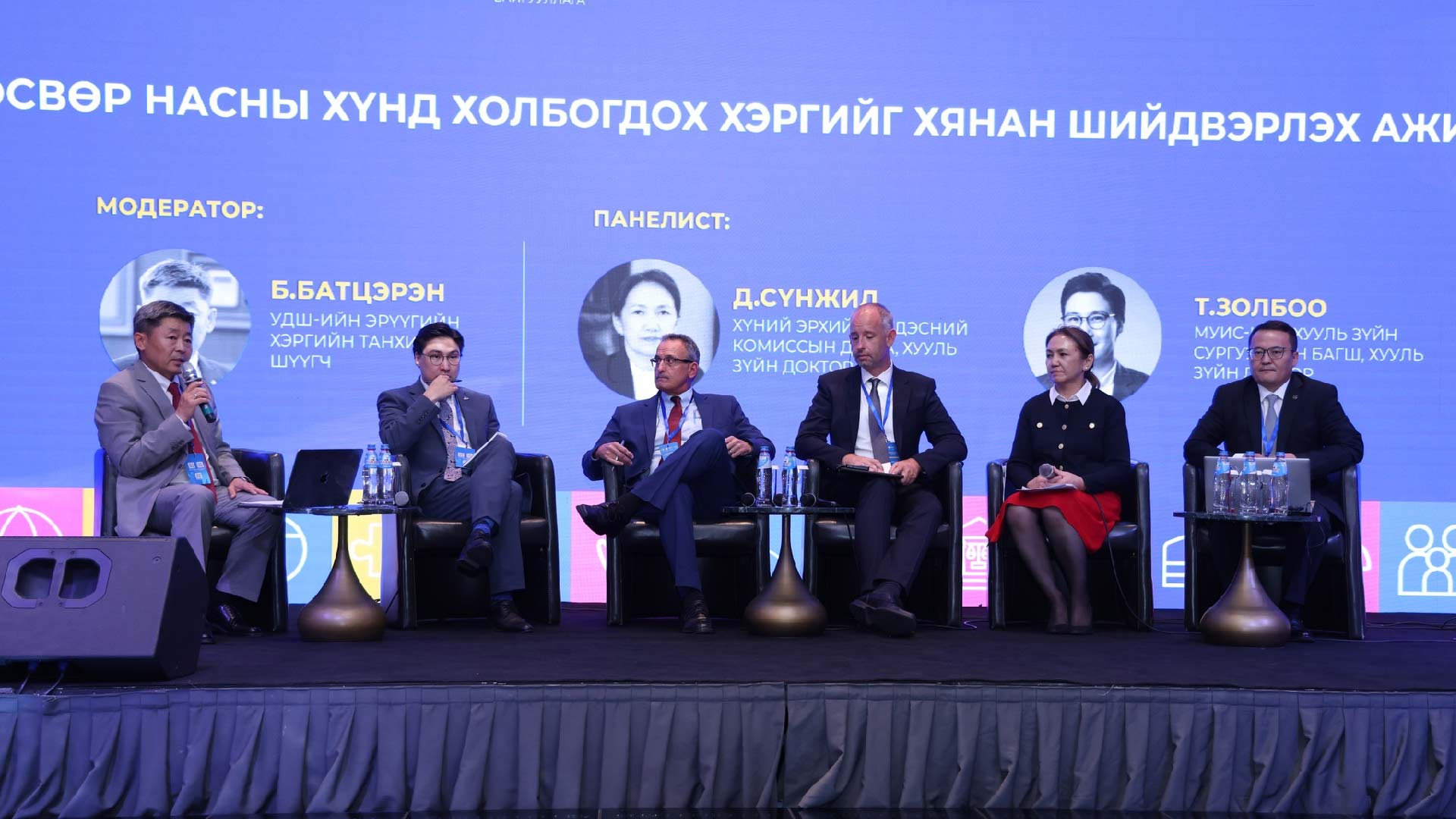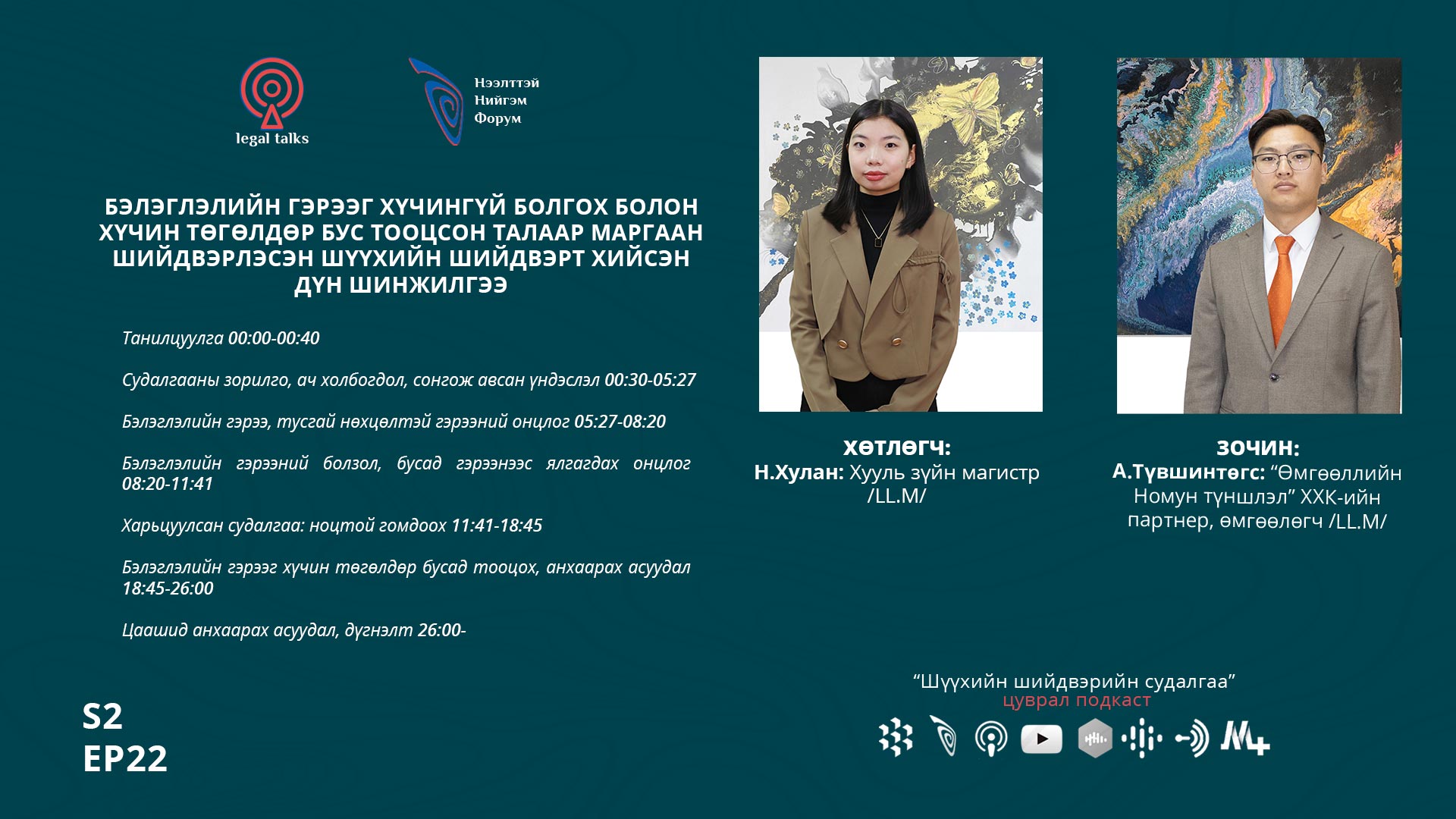Бүртгэлтэй бол нэвтрэх | Бүртгэлгүй бол бүртгүүлэх
1 Among the variety of definitions on intergovernmental organisations, Volgy et al. suggested the definition that ‘intergovernmental organisations are entities created with sufficient organizational structure and autonomy to provide formal ongoing, multilateral processes of decision making between states, along with the capacity to execute collective will of their members.’ See T. J. Volgy et al., ‘Identifying Formal Intergovernmental Organizations’, Journal of Peace Research, vol. 45, no. 6, 2008, pp. 837-850.
2 The term ‘general-purpose organization’ was used in several other writings. For instance, see generally L. Hooghe and G. Marks, ‘Delegation and Pooling in International Governmental Organizations’, The Review of International Organizations, vol. 10, no. 3, 2014, pp 305-328; G. Goertz and K. Powers, ‘Regional Governance: The Evolution of a New Institutional Form’, Workshop on an International Organization Database, Wissenschaft szentrum für Sozialforschung, Berlin, 2014.
3 K. J. Alter and L. Hooghe, ‘Regional Dispute Settlement Systems’ in T. A.Borzel and T. Risse (ed.), Oxford Handbook of Comparative Regionalism, Oxford, Oxford University Press, 2016, p. 542.
4 J. Klabbers, ‘Unity, Diversity, Accountability: The Ambivalent Concept of International Organisation’, Melbourne Journal of International Law, vol. 14, 2013, p. 3.
5 United Nations,Charter of the United Nations, 24 October 1945,1 UNTS XVI.
6 See A. McBeth, J. Nolan and S. Rice, The International Law of Human Rights, Australia and New Zealand, Oxford University Press, 2011, p.11.
7 United Nations,Article 2, para 3.
8 United Nations, Article 33 (1).
9 United Nations, Article 52 (2).
10 See General Assembly, Resolution No. 2627, “Declaration on the occasion of the Twenty-fifth Anniversary of the United Nations” of 24 October 1970, [website], 2017, https://documents-dds-ny.un.org/doc/RESOLUTION/GEN/NR0/348/92/PDF/NR034892.pdf?OpenElement,(accessed 18 April 2017).
11 See General Assembly, Resolution No. 2734, “Declaration on the Strengthening of International Security” of 16 December 1970, [website], 2017, https://documents-dds-ny.un.org/doc/RESOLUTION/GEN/NR0/349/99/IMG/NR034999.pdf?OpenElement, (accessed 18 April 2017).
12 M. Evans and P. Koutrakos, Beyond the established legal orders : policy interconnections between the EU and the rest of the world, Oxford, Hart Publishing, 2011. p. 235.
13 P. Fisher, ‘International Organizations’, Vienna; Bratislava, 2012,http://www.worldmediation.org/education/io-1.pdf, (accessed 01 April 2017). p. 25.
14 See generally The Council of Europe, Statute of the Council of Europe, ETS No.001, 1949, [website], http://www.coe.int/en/web/conventions/full-list/-/conventions/treaty/001, 2017, (accessed 27 April 2017).
15 The Council of Europe, European Convention for the Peaceful Settlement of Disputes, 1957, [website], 2017, https://rm.coe.int/CoERMPublicCommonSearchServices/DisplayDCTMContent?documentId=0900001680064586(accessed 21 April 2017).
16 United Nations, Handbook on the Peaceful Settlement of Disputes between States. New York, United Nations Publication, 1992, p.86.
17 J. G. Merrills, International Dispute Settlement. 5th ed. Cambridge, Cambridge University Press, 2011, p.258.
18 The European Union, Treaty of the European Union, EUR-Lex, [website] http://eur-lex.europa.eu/legal-content/en/TXT/?uri=CELEX%3A12012M%2FTXT, (Accessed 10 April 2017).
19 The European Union, Article 21 para 1.20The European Union, Article 21 para 2 (c).
21 See generally MERCOSUR, Protocolo De Olivos: Para la Solucion De Controversias En El MERCOSUR, 2002 [website], 2017, http://www.mercosur.int/innovaportal/file/722/1/2002_protocoloolivossolucontroversias_es.pdf(accessed 17 April 2017).
22 See generally Southern African Development Community (SADC), Protocol on Tribunal in the Southern African Development Community, 2000, [website], http://www.sadc.int/files/1413/5292/8369/Protocol_on_the_Tribunal_and_Rules_thereof2000.pdf, (accessed 17 April 2017).
23 See generally Caribbean Community (CARICOM), Protocol IX: Dispute Settlement, 2000, [website], http://archive.caricom.org/jsp/secretariat/legal_instruments/protocolix.jsp?menu=secretariat&prnf=1, (accessed 17 April 2017).
24 See generally Economic Community of West African States (ECOWAS), Protocol on the Communtiy Court of Justice, [website], 1991, http://www.courtecowas.org/site2012/pdf_files/protocol.pdf(accessed 17 April 2017).
25 See generally Central American Integration System (SICA), Convention for the Establishment of a Central American Court of Justice, 1908, [website], http://www.worldcourts.com/cacj/eng/documents/1907.12.20_convention.htm, (accessed 17 April 2017).
26 See generally East African Community (EAC), Annex on the Tripartite Dispute Settlement Mechanism, 2010, [website], http://www.tralac.org/wp-content/blogs.dir/12/files/2011/uploads/Tripartite_FTA_Annex_13_dispute_settlement_Revised_Dec_2010.pdf, (accessed 17 April 2017).
27 See generally Association of Southeast Asian Nations (ASEAN), Protocol on Enhanced Dispute Settlement Mechanism, 2010, [website], http://asean.org/?static_post=asean-protocol-on-enhanced-dispute-settlement-mechanism,(accessed 17 April 2017).
28 J. Tallberg and J. McCall Smith, ‘Dispute settlement in world politics: States, supranational prosecutors, and compliance’, European Journal of International Relations, vol. 20, no. 1, 2014, p. 121.
29 See generally K. J. Alter and L. Hooghe, ‘Regional Dispute Settlement Systems’ in T. A.Borzel and T. Risse (ed.), Oxford Handbook of Comparative Regionalism, Oxford, Oxford University Press, 2016.
30 B. Zangl et al., ‘Between law and politics: Explaining international dispute settlement behavior’, European Journal of International Relations, vol.18, no. 2, 2012, p.370.
31 The Common Market for Eastern and Southern Africa (COMESA), 2017, [website], http://www.comesa.int/, (accessed 25 April 2017).
32 Southern African Development Community (SADC), 2017, [website], http://www.sadc.int/, (accessed 25 April 2017).
33 East African Community (EAC), 2017, [website], http://www.eac.int/(accessed 25 April 2017).
34 B. Zangl et al., ‘Between law and politics: Explaining international dispute settlement behavior’, p.370.
35 M. Al-Qahtani, ‘The Shanghai Cooperation Organization and the Law of International Organizations’, Chinese Journal of International Law, vol. 5, no. 1, 2006, p. 130.
36 The Shanghai Cooperation Organisation, Declaration on Establishment of Shanghai Cooperation Organization, [website] 2017, http://eng.sectsco.org/load/193054/, (accessed 11 April 2017).
37 The Shanghai Cooperation Organisation, The Charter of the Shanghai Cooperation Organization, [website] 2017, http://eng.sectsco.org/load/203013/, (accessed 10 April 2017).
38 The Shanghai Cooperation Organisation, Permanent Representatives to the SCO Secretariat, [website] 2024, https://eng.sectsco.org/20220907/911976.html, (accessed 21 October 2024).
39 TASS, Belarus officialy joins SCO as 10thmember, https://tass.com/world/1812205, (accessed 21 October 2024).
40 See Introduction for the common characteristics of the IGO.
41 Z. Kembayev, ‘Towards a Silk Road Union?’, Chinese Journal of International Law, vol. 15, no. 3, 2016, pp. 691-699.
42 The Shanghai Cooperation Organisation, The Charter of the Shanghai Cooperation Organization, [website] 2017, http://eng.sectsco.org/load/203013/, (accessed 10 April 2017) Article 15.
43 See Introduction for the characteristics described by Alter and Hooghe.
44 See generally The Shanghai Cooperation Organisation, The Charter of the Shanghai Cooperation Organization, [website] 2017, http://eng.sectsco.org/load/203013/, (accessed 10 April 2017) Article 1.
45 Russia and China are the permanent members of the UN Security Council. See United Nations,Charter of the United Nations, 24 October 1945,1 UNTS XVI, Article 23.
46 Kazakhstan was appointed as a non-permanent member of the UN Security Council in 2016. See United Nations News Centre, Sweden, Bolivia, Ethiopia and Kazakhstan elected to Security Council, [website], 28 June 2016, https://www.un.org/apps/news/story.asp?NewsID=54350#.WQFs-YiGPDc(accessed 14 April 2017).
47 The Shanghai Cooperation Organisation, Declaration on Establishment of Shanghai Cooperation Organization, [website] 2017, http://eng.sectsco.org/load/193054/, (accessed 11 April 2017). Para. 2.
48 General Assembly Resolution, A/RES/59/48, 2004. [website], http://repository.un.org/bitstream/handle/11176/251299/A_RES_59_48-EN.pdf?sequence=3&isAllowed=y, (accessed 18 April 2017)
49 M. Al-Qahtani, ‘The Shanghai Cooperation Organization and the Law of International Organizations’, Chinese Journal of International Law, vol. 5, no. 1, 2006, p. 144.
50 The Shanghai Cooperation Organisation, The Tashkent Declaration of the Fifteenth Anniversary of the Shanghai Cooperation Organization, [website], 2017, http://eng.sectsco.org/load/207886/, (accessed 14 April 2017).
51 The Shanghai Cooperation Organisation, The Charter of the Shanghai Cooperation Organization, Article 2.
52 See The Shanghai Cooperation Organisation, The Charter of the Shanghai Cooperation Organization, [website] 2017, http://eng.sectsco.org/load/203013/, (accessed 10 April 2017).
53 In the text of the Tashkent Declaration, it reads: “Member States intend to continue to adhere to universally recognized objectives and principles of the UN Charter and international law, primarily relating to the maintenance of international peace and security, development of cooperation between states, independence, equality, independent choice of social systems and paths of development, mutual respect for sovereignty, territorial integrity, inviolability of borders, non-aggression, non-interference in internal affairs, peaceful settlement of disputes, non-use of force or threat of force.” See the Shanghai Cooperation Organisation, The Tashkent Declaration of the Fifteenth Anniversary of the Shanghai Cooperation Organization, [website], 2017, http://eng.sectsco.org/load/207886/, (accessed 14 April 2017).
54 The Tashkent Declaration of the Fifteenth Anniversary of the Shanghai Cooperation Organization, [website], 2017, http://eng.sectsco.org/load/207886/, (accessed 14 April 2017).
55 E. Azarkan, ‘The Interests of the Central Asian States and the Shanghai Cooperation Organization’, Ege Academic Review, vol. 10, no. 1, 2010, p.396.
56 The Shanghai Cooperation Organization, Agreement between the Governments of the Member States of the Shanghai Cooperation Organization on Creating Favorable Conditions for International Road Transportation, [website], 2014, http://eng.sectsco.org/load/207681/, (accessed 14 April 2017). Article 26.
57 M. Al-Qahtani, The Shanghai Cooperation Organization and the Law of International Organizations, Chinese Journal of International Law, vol. 5, no. 1, 2006, p. 139.
58 Ibid.
59 See footnote 49.
60 Aris, S., ‘A new model of Asian regionalism: does the Shanghai Cooperation Organisation have more potential than ASEAN?’, Cambridge Review of International Affairs, vol. 22, no. 3, 2009. p. 453.
61 See generally N. Yasuda, ‘Law, Legal Culture and regional Integration: Asian Perspectives’, APEC Discussion Paper Series, no. 7, 1996.
62 N. Yasuda, ‘Dispute Settlement Mechanisms in Asia-Pacific Region –APEC DMS and ASEAN DMS’, APEC Discussion Paper Series, no. 13, 1997, p.25.
63 N. Yasuda, ‘Law, Legal Culture and regional Integration: Asian Perspectives’, APEC Discussion Paper Series, No. 7, 1996, p.5.
64 Aris, S., ‘A new model of Asian regionalism: does the Shanghai Cooperation Organisation have more potential than ASEAN?’, p. 464.
65 ASEAN, Protocol on the ASEAN Dispute Settlement Mechanism, 1996, [website], http://agreement.asean.org/media/download/20140119110714.pdf, (accessed 21 April 2017).
66 ASEAN, Protocol to the ASEAN Charter on Dispute Settlement Mechanisms, 2010 [website], http://agreement.asean.org/media/download/20160829075723.pdf, (accessed 21 April 2017).67Ibid. Article 8-12.
68 See generally A. J. K. Bailes, P. Dunay, P. Guang and M. Troitsky, The Shanghai Cooperation Organization. Stockholm International Peace Research Institute (SIPRI), 2007.
69 R. Burchill, ‘Regional organizations and the UN legal order’, in International Organizations and the Idea of Autonomy, Taylor and Francis, 2011, p. 332.
МЭДЭЭ, МЭДЭЭЛЭЛ

“Дагнасан шүүхийн тогтолцоо: Хүүхдийн эрх ашиг ба гэр бүл” олон улсын эрдэм шинжилгээний хурал (III хэсэг)
1 day ago

“Дагнасан шүүхийн тогтолцоо: Хүүхдийн эрх ашиг ба гэр бүл” олон улсын эрдэм шинжилгээний хурал (II хэсэг)
3 days ago

S2EP22. А.Түвшинтөгс: Бэлэглэлийн гэрээг хүчингүй болгох болон хүчин төгөлдөр бус тооцсон талаар маргаан шийдвэрлэсэн шүүхийн шийдвэрт хийсэн дүн шинжилгээ
5 days ago

“Дагнасан шүүхийн тогтолцоо: Хүүхдийн эрх ашиг ба гэр бүл” олон улсын эрдэм шинжилгээний хурал (I хэсэг)
5 days ago
ШҮҮХИЙН ШИЙДВЭРИЙН ХУРААНГУЙ
-
Даатгуулагч нэн даруй мэдэгдэх үүргээ биелүүлээгүй нь даатгагчийн ашиг сонирхолд ноцтой хохирол учруулаагүй бол нөхөн төлбөрийг төлөх үүрэгтэй
2025-06-29
-
Түр саатуулах хугацаа тооцох заалт нь Үндсэн хууль зөрчсөн тухай Цэцийн дүгнэлт (2024, №03)-ийн тойм
2025-06-27
-
Ашиглалтын тусгай зөвшөөрөл бүхий талбайн газрын төлбөрийг уурхайн эдэлбэр газрын хэмжээгээр ногдуулж төлнө
2025-06-27
-
Эрхэмбаярын Энхцэцэг
2025-07-01 Эрдэм шинжилгээний өгүүлэлдуудаж байна ! -
Нээлттэй Нийгэм Форум Ө.Болортуяа, Б.Ганцэцэг, М.Насанбат, Н.Номинзул
2025-06-30 Эрх зүйн шүүмждуудаж байна ! -
Элбэгзаяагийн Төгстөгөлдөр
2025-06-30 Эрдэм шинжилгээний өгүүлэлдуудаж байна ! -
Ганбат Мөнхтулга
2025-06-26 Эрдэм шинжилгээний өгүүлэлдуудаж байна ! -
Батсайханы Мөнхзул
2025-06-26 Эрдэм шинжилгээний өгүүлэлдуудаж байна ! -
Ганбат Мөнхтулга
2025-06-25 Эрдэм шинжилгээний өгүүлэлдуудаж байна ! -
Баатарын Сарантуяа
2025-06-24 Эрдэм шинжилгээний өгүүлэлдуудаж байна ! -
Ганбат Мөнхтулга
2025-06-24 Эрдэм шинжилгээний өгүүлэлдуудаж байна ! -
Judilogy
2025-06-23 Мэдээллийн хуудасдуудаж байна ! -
Ганбат Мөнхтулга Нэрэндашийн Дуламсүрэн
2025-06-23 Эрдэм шинжилгээний өгүүлэлдуудаж байна !